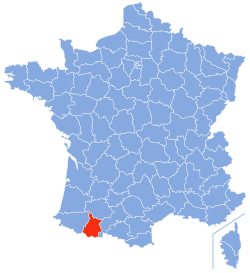Hautes Pyrénées
| Hautes-Pyrénées | ||
|---|---|---|
| Department | ||

Prefecture building of the Hautes-Pyrénées department, in Tarbes
|
||
|
||
 Location of Hautes-Pyrénées in France |
||
| Coordinates: 43°12′N 0°8′E / 43.200°N 0.133°ECoordinates: 43°12′N 0°8′E / 43.200°N 0.133°E | ||
| Country | France | |
| Region | Occitanie | |
| Prefecture | Tarbes | |
| Subprefectures |
Argelès-Gazost Bagnères-de-Bigorre |
|
| Government | ||
| • President of the General Council | Michel Pelieu | |
| Area | ||
| • Total | 4,464 km2 (1,724 sq mi) | |
| Population (2013) | ||
| • Total | 228,868 | |
| • Rank | 84th | |
| • Density | 51/km2 (130/sq mi) | |
| Time zone | CET (UTC+1) | |
| • Summer (DST) | CEST (UTC+2) | |
| Department number | 65 | |
| Arrondissements | 3 | |
| Cantons | 17 | |
| Communes | 470 | |
| ^1 French Land Register data, which exclude estuaries, and lakes, ponds, and glaciers larger than 1 km2 | ||
Hautes-Pyrénées (French pronunciation: [ot pi.ʁe.ne]) (Gascon/Occitan: Nauts Pirenèus / Hauts Pirenèus ['awts piɾeˈnɛʊs]; Spanish: Altos Pirineos; Catalan: Alts Pirineus ['alts piɾiˈneʊs]) is a department in southwestern France. It is part of the Occitanie region.
Historically the area broadly covered by the département was known as Bigorre, a territory at times independent but later part of Gascony province. Large parts of the area were held by the English after the Treaty of Brétigny, 1360. In the 16th century, it was part of the Huguenot domain of the monarchs of Navarre, brought to France by Henri IV. For its early history, see Bigorre and Gascony.
The département of Hautes-Pyrénées was created at the time of the French Revolution, on 4 March 1790, through the influence of Tarbes politician Bertrand Barère, a member of the Convention.
Hautes-Pyrénées consists of several distinct geographical areas. The southern portion, along the border with Spain, consists of mountains such as the Vignemale, the Pic du Midi de Bigorre, and the Neouvielle and Arbizon ranges. A second area consists of low-altitude rolling hills. The Northern part of the département consists of largely flat agricultural land. Hautes-Pyrénées has two small territorial exclaves—a remnant from the Middle Ages—located within the neighboring département of Pyrenees-Atlantiques.
...
Wikipedia

